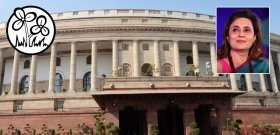August 5, 2024
Sagarika Ghose’s speech during the discussion on the Ministry of New and Renewable Energy

Hon. Deputy Chairman, Sir, this is a crucial Ministry. It concerns the future of us and the future of the planet. Sir, for the last ten years, this Government has been playing the role of ‘Sapno Ka Saudagar’, merchant of dreams. They are showing sapna, which is dreams, that does not match with reality, which is the hakikat. Nowhere is this gap between Sapna and Hakikat more pronounced than in the Ministry of New and Renewable Energy. Let me present some facts. At COP26, that is the 2021 climate conference in Glasgow, the Prime Minister said that India will produce capacity of 500 Gigawatts of renewable energy capacity by 2030. What has the Government done? The story of this Government is missing targets, focusing only on big projects and not on small-scale decentralized renewables. And third, it is actually Bengal, which is a pioneer in renewable energy and which is creating small-scale renewables. So, unlike Manu Bhaker, who is hitting the target in the Olympics, this Government is continually missing targets. The Government’s target for installed capacity for renewable energy for 2022, let’s forget 2030, for 2022 was 100 Gigawatts of installed capacity for solar and 60 Gigawatts of installed capacity for wind. Where are we in 2024? Only 81.6 Gigawatts for solar and 45.8 Gigawatts for wind. These are the Government’s own figures of Central Electricity Authority Report. I hope the Ministry will tell us how it intends to catch up to 2022 from 2024 because its figures, its targets for 2022 have not been met, forget 2030. Let us now focus on energy because the Government keeps giving impressive figures on installed capacity, but how much electricity are you actually generating? We have to track generation. From April 2023 to March 2024, total electricity generated from solar was only 6.69 per cent of total electricity generation of the country. Electricity from wind was only 4.71 per cent of total electricity generated in the country. If you add all the new renewables, that is wind, solar, small hydro and biomass, this comes to only 13 per cent of the total electricity generated in the country. According to the Prime Minister’s announcement in 2021, the Government is aiming for 32 per cent of total electricity generation of the country by 2030. This figure has been revised upwards to 43 per cent of total electricity from renewables by 2030. You are aiming for 32 per cent and 43 per cent, but until now you are generating only 13 per cent; Sapna- Hakikat. And you have achieved this 13 per cent only after two decades. The program began in 2006 under Dr. Manmohan Singh when the Ministry was named New and Renewable energy. But in two decades, from 2006 to 2024, you have only produced 13 per cent of electricity. They are showing photographs of giant solar parks, giant installed capacity, but not enough attention is being paid to custom-made, small-scale renewables. Which actually meet local demands at the price that people can afford; solar dryers, small horticulture, small refrigerators, streetlights. There is not enough focus on decentralized small-scale renewables and spreading awareness and usage of renewables. How many of us are using renewables today? The Government is not spreading awareness! The Government is not going to the people to find out what people actually need in terms of energy and what price they are willing to pay. Sir, there is also a price to be paid for these huge Solar Parks that the Government is setting up. At the Pavagada Solar Park in Karnataka and the Charanaka Solar Park in Gujarat, thousands of farmers have been displaced and lost their livelihoods because of these gigantic solar parks. Sir, the Ministry has its own Report – the Decentralized Renewable Energy for Rural Livelihoods Report of 2022. But, they are ignoring this Report, because they want to make photographs of big-ticket Gigawatt projects for the international audience! Sir, it is actually the Bengal Government which is pioneer in renewable energy and creating small-scale renewables. Sir, two lakh families in Bengal use renewable energy resources as primary source of electricity. More than 11,000 solar street lighting systems have been installed in different parts of the Sundarbans. Sir, 58 Government buildings under the Aloshri program have been provided with solar power plants. Bengal has established the country’s first solar housing complex – the Rabir Rashmi housing complex – in Newtown. So, we cannot afford to dilly-dally on new and renewable energy. India’s 70 per cent of electricity is coming from coal. This is resulting in greenhouse gas emissions which is engulfing the planet. The future of our children is at stake, the species is at stake and we are in danger. And, what is the Government doing? The Government is only putting out photographs and announcements for international audiences, but not doing anything to encourage small-scale renewables, to encourage usage of renewables and to encourage small-scale deliverables of renewables. I want to say, Sir, it is the Bengal Government which is, actually, doing/working for small-scale renewable energy and small-scale renewables. The Government is talking about ‘sapna’ and ‘dreams, but it is the Bengal Government which is working on ‘haquikat’ or ‘reality’ on new and renewable energy. Thank you.
